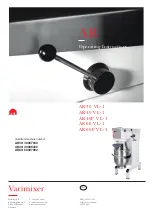
29
triggered, the Soft button LED lights up. This setting would be
used to create a hotline phone ring indicator.
•
Toggle – Sets the switch to function as a sustained mechanical
toggle switch. A logic-only destination is created with the
Direction: output and Function: Switch 1. The Surface itself
controls the button LED, indicating whether the output logic is on
(button is lit) or off (button is unlit). This setting might be used to
control studio access (studio door locked = lit, unlocked = unlit).
•
Momentary/Surface LED - Sets the switch to be momentary. A
logic-only destination is created with the Direction: output and
Function: Switch 1. The Surface controls the button LED, lighting it
to indicate the button is being pressed. This setting might be used
to create a talk button to talk to a call screen or producer position.
•
Momentary/LIO LED – Sets the switch to trigger a logic output
while pressed and sets the LED to be controlled by a logic input. It
combines the logic-only settings for Tally and Toggle. This setting
could create a profanity delay Dump button, with the LED being
the Safe or Dump Ready indicator.
Visibilities Page Tab
Each DMX source selector: fader channel; CR monitor; Studio monitor;
and Switched Meter, has its own Visibilities List to set which alternate
sources are displayed while using that type source selector.
The default Visibility setting for all selectors is to display all sources. This
is desirable for installing the console since it allows any source to be
“dialed up” anywhere. But, for daily operation of the console, it’s essential
that the Visibilities lists--especially on the fader channels, are edited to
remove signals that should not be shown, like the PGM buses and other
internal console signals as well non-air sources like pre-delays and tuners.
Figure 3-12 shows the Visibilities page tab with the Channel 1 Source
Selector highlighted. This channel is typically dedicated to the board
operator or host mic. In the example, there are five sources checked: the
left channel of the Analog In 1 jack (BL05MIC1), plus four Alias names,
and Allow No Source. When the channel 1 encoder is rotated, NoSource,
BL05MIC1, GEORGE, JOHN, PAUL, and RINGO will appear in the
channel 1 display. If NoSource is taken, it silences that channel. Taking
any other source displays that name which, in this case, includes four
“talent names” all associated with MIC 1.
If Allow No Source is unchecked that name won’t appear in that list of
alternate sources. This is typically done on the Switched Meter, Control
Room and Studio selectors since they should not be silenced at any time.
The default Visibility setting, for all selectors, is to display all sources.
But, for daily operation of the console, it’s essential that the list of visible
sources be narrowed, if only to prevent a Program bus from being taken
on a channel and then assigned to the same bus. Doing this will cause
“digital feedback” as the fader is potted up which can overload the bus,
causing it to mute.
Figure 3-12 Visibilities Page Tab Settings
Visibility Lists
On fader channels with a dedicated source, like the Host mic or phone
channel, only one source, or maybe several talent name Aliases are
checked along with NoSource.
On media server playback channels, there is often a B Serve or backup
server, so typically the main and B Serves on the media server channels
















































